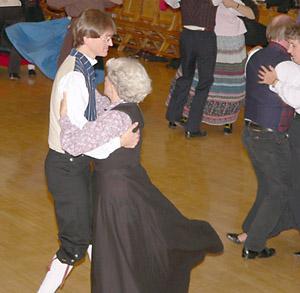

Nordic folk dances are generally done in couples, with the exception of a few virtuoso solo dances. They include turning dances as well as set dances for groups of couples. Swedish and Norwegian dance rely heavily on the turning forms, some of which are based on Continental European turning dances. Danish folk dancing is dominated by set dances for four couples and ring dances, which largely date from the late 1700's to late 1800's.
For social occasions it is customary today to dance one or two dances with one partner and then dance with another person. In classes, partners are often rotated to speed learning. There is no expectation that one attend with a partner, as it is usual to dance with many different people during a session.
The man's and woman's steps are usually complementary and are sometimes a mirror image of one another. Whether one is leading or following in a dance, it is always interesting to be in tune with the music, your partner, and the other dancers in the hall. The dances engage a person's intellect, body, and social skills.
Some dance distinctions respect national boundaries, but there are many similarities which transcend national borders. There are dozens of dances now documented, but they can be organized into several major styles.
These village dances originated in certain villages or towns and are usually named after those villages.
They are typically danced in a free-form fashion, with the basic parts done in a sequence determined by the leader during the dance. Formerly bygdedansar (pl.) were only known by local people, but many have made it into the standard repertoire of Scandinavian dancing. A common example is the Bingsjö Polska from central Sweden or the many different types of springars from Norway. They can be quite old, and some that are done widely today are known to date from around 1600. In Norway, the dances are said to be in a living tradition, i.e. they have been danced continuously over the centuries. In recent years, dance teachers have documented them for all time. The Swedish dances waned during the 20th Century, but were finally documented based on observation of elderly dancers. In addition to having been taken up by another generation of dancers, they are now preserved in written and video form.
These few dances are widely known in the Nordic countries and beyond and done all over the region, as well as in other countries. Translated as "old dance," this type developed after the bygdedansar. Gammeldans generally consists of the vals (waltz), schottische/schottis/reinlender, polka, snoa, and sometimes the mazurka. They are very popular on social occasions because they are easy to learn and known by a large number of people.
These figure dances are choreographed, often for show or performance reasons. The parts of the dance are normally danced in a pre-determined sequence. An example is the Norwegian Pariser Polka, which is a series of standardized variations on a pattern of walking and turning. Turdanser (plural of Turdans in Norwegian) are often danced only to a particular tune. They did not grow out of tradition directly but capture main elements of the traditional dances.
Many of the dances have a rich history, sometimes going back hundreds of years. One of our favorites is the Norwegian Røropols, a bygdedans pols from the historic Røros mining district in eastern Norway, which is now a UNESCO World Heritage site. The history of this dance and a few others we do in condensed form are at: Background.
The dances are often named after the villages where they were discovered or from where they originate. Many of the namesake villages themselves have rich histories spanning a century or more. An example is the Danish dance Sønderhoning, from the village of Sønderho in Jutland. A history of the village is given here.
A list of the dances we have done is here
Videos of many different folk dances, Nordic, and from other countries, can be found at the Dancilla web site. A sub page listing only Swedish dances is linked from there. Best viewed over a high-speed connection.
Links to a number of specific traditional dances are compiled here.
More links to a variety of dances, some traditional and some more modern are at this page.
Two pairs dancing the Rørosols at a festival in Norway is shown here.
A couple of Swedish set dances are at these links:
Some information from Alix Cordray, dance instructor, and from the Ålesund Spelemannslag.
Site created by John Hingtgen.
16 Jul 2020 © SAND
|
SAND home page |